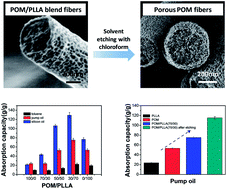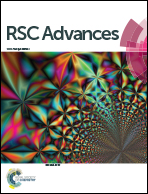Electrospun nanofibers with both surface nanopores and internal interpenetrated nanochannels for oil absorption†
Abstract
Polyoxymethylene (POM) nanofibers with both surface nanopores and internal interpenetrated channels have been fabricated by the electrospinning of POM/poly(L-lactide) (PLLA) blends and followed by the solvent etching of the PLLA component in the fibers. With the fast evaporation of the solvent, vapor-induced phase separation between the solvent and the POM/PLLA blends occurs on the surface of the nanofibers, which leads to numerous nanopores on the surface of the as-spun nanofibers. At the same time, POM and PLLA form a co-continuous structure in the fibers and the subsequent etching of the nanofibers by chloroform induces the removal of PLLA and the formation of the internal nanochannels in the fibers. The fabricated novel porous POM nanofibers with both surface pores and internal channels exhibit a much higher oil absorption capacity than both the neat POM nonwoven fabrics and the POM/PLLA blend nonwoven fabrics. The porous POM nonwoven fabrics from POM/PLLA (70/30) has a pump oil absorption capacity of 115.3 g g−1, compared to 75.2 g g−1 for the as-spun POM/PLLA blend and 53.2 g g−1 for the neat POM nonwoven fabric. It was further found that the novel hierarchical porous structure makes the materials be an ideal alternative for both oil absorption and oil/water separation.



 Please wait while we load your content...
Please wait while we load your content...